How to Choose a Patio Heat Lamp Electric
There are a variety of options when it comes to heating your patio. In contrast to propane heaters that require refills electric heaters can provide instant heat by simply flicking an switch or pressing a button.
They don't emit gasses that could cause the risk of health hazards. Some models have adjustable temperature settings for different distances.
Heater Type
With the right patio heater, you will be able to comfortably relax in your outdoor living spaces into the night, and throughout the seasons. Patio heaters are available in many varieties including freestanding propane models, natural gas models as well as ceiling or wall-mounted electric radiant heaters. The choice you make will depend on the dimensions of the space, the power sources available and personal preference.
Most patio heaters use electricity, natural or liquid gas to generate heat. They release heat through convection heating as well as radiant heating. The output of heat from patio heaters is measured in watts, which can be converted to British thermal units (BTUs), for comparison. Some models also have adjustable heat settings to allow for greater flexibility.
Patio heat lamps include an electric burner on a pole, and an aperforated screen that reflects flames and radiates heat downwards to warm people, objects and furniture. Some have a reflector atop the burner that can be plated with silver to decrease the amount of heat lost upwards.
The most popular type of patio heater is a gas patio heater, is often seen in outdoor seating areas of restaurants and bars as they generate a lot of heat quickly and spread equally across all directions, making them ideal for warming multiple tables. They are portable and can run on a propane tank or connected to your natural gas line. This is more convenient and comes with lower initial costs, but requires fuel.
A increasing number of homes are fitted with natural gas lines, which makes them the perfect solution for those who prefer a gas patio heater. They are easy to install, but they require a gas line that's properly installed and working to be secure. There are portable natural gas heaters equipped with extension hoses which can help overcome this restriction however they can also create a tripping hazard and a fire risk when not in use.

Safety
The majority of electric patio heaters are safe to use in enclosed areas due to their ability for heat to radiate outward instead of upwards towards material that is combustible, such as the roof. They are not intended for use under an unprotected roof. The heater must be placed at least 6" away from the ceiling and 18" away from the adjacent wall to avoid fire hazards.
The propane and gas patio heaters are typically suitable for use in enclosed areas that have the proper cover designed for open-air use. These types of covers are typically made of fire-resistant canvas and have the option of having a roof that is closed. These kinds of patio heaters have security concerns due to the flames and fumes they generate. They should be kept away from any objects that could ignite, such as curtains and chairs.
When installing a patio heat lamp electric or any kind of patio heater, be sure to adhere to the manufacturer's instructions and safety precautions carefully. Make sure you select the one with UL and CSA certifications, and also read the owner's guide carefully. Be extra cautious with pets and children and make sure the heater isn't within their reach when it's in operation. Some free-standing patio heaters, such as EUROM, have a built-in tipping protection that shuts down the device if it falls over.
If your patio heater runs on a natural gas line it is essential to inspect the condition of the line on a regular basis and to be tested for leaks by a certified professional. If click for source needs to be replaced, make sure to employ an authorized plumber. A professional will be able to determine if the line is properly routed or if it should be routed through an underground pipe. A professional can also ensure that the heater for your patio is plugged in to an outlet that is GFCI-rated (ground fault circuit interrupter) to protect against electric shocks and fires.
Installation
The size of the patio heater determines the amount of heat it emits into the space. It is essential that the heater is placed at an appropriate distance from any surfaces like plastic, which can deform as well as wood, which may get too hot. You can mount the heater on a structure, wall or other surface using traditional mounting brackets. Some models feature soft starters, which reduces the peak current to protect your circuits.
